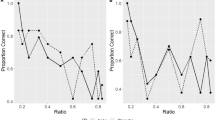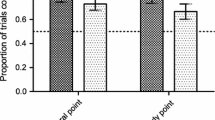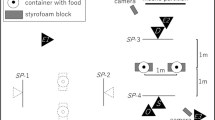Abstract
Asian elephants have previously demonstrated an ability to follow olfactory cues, but not human-provided social cues like pointing and gazing or orienting to find hidden food (Plotnik et al. in PLoS One 8:e61174, 2013; Anim Behav 88:91–98, 2014). In a study conducted with African elephants, however, elephants were able to follow a combination of these social cues to find food, even when the experimenter’s position was counter to the location of the food. The authors of the latter study argued that the differences in the two species’ performances might have been due to methodological differences in the study designs (Smet and Byrne in Curr Biol 23(20):2033–2037, 2013). To further investigate the reasons for these potential differences, we partially adapted Smet and Byrne (2013)’s design for a group of Asian elephants in Thailand. In a two-object-choice task in which only one of two buckets was baited with food, we found that, as a group, the elephants did not follow cues provided by an experimenter when she was positioned either equidistant between the buckets or closer to the incorrect bucket when providing the cues. The elephants did, however, follow cues when the experimenter was closer to the correct bucket. In addition, there was individual variability in the elephants’ performance within and across experimental conditions. This indicates that in general, for Asian elephants, the pointing and/or gazing cues alone may not be salient enough; local enhancement in the form of the experimenter’s position in relation to the food reward may represent a crucial, complementary cue. These results suggest that the variability within and between the species in their performance on these tasks could be due to a number of factors, including methodology, the elephants’ experiences with their handlers, ecological differences in how Asian and African elephants use non-visual sensory information to find food in the wild, or some combination of the three.

Similar content being viewed by others
References
Bates LA, Sayialel KN, Njiraini NW, Moss CJ, Poole JH, Byrne RW (2007) Elephants classify human ethnic groups by odor and garment color. Curr Biol 17:1938–1942
Bates LA, Sayialel KN, Njiraini NW, Poole JH, Moss CJ, Byrne RW (2008) African elephants have expectations about the locations of out-of-sight family members. Biol Let 4:34–36
Call J (2004) Inferences about the location of food in the great apes (Pan paniscus, Pan troglodytes, Gorilla gorilla, and Pongo pygmaeus). J Comp Psychol 118(2):232–241
Call J, Agnetta B, Tomasello M (2000) Cues that chimpanzees do and do not use to find hidden objects. Anim Cogn 3:23–34
de Silva S, Wittemyer G (2012) A comparison of social organization in Asian elephants and African savannah elephants. Int J Primatol 33(5):1125–1141
Essler JL, Schwartz LP, Rossettie MS, Judge PG (2017) Capuchin monkeys’ use of human and conspecific cues to solve a hidden object choice task. Anim Cogn 20(5):985–998. https://doi.org/10.1007/s10071-017-1118-2
Giret N, Miklósi A, Kreutzer M, Bovet D (2009) Use of experimenter-given cues by African gray parrots (Psittacus erithacus). Anim Cogn 12:1–10
Hare B (2001) Can competitive paradigms increase the validity of social cognitive experiments on primates? Anim Cogn 4:269–280
Hare B, Tomasello M (1999) Domestic dogs (Canis familiaris) use human and conspecific social cues to locate hidden food. J Compar Psychol 113(2):173–177
Hare B, Tomasello M (2004) Chimpanzees are more skillful in competitive than in cooperative cognitive tasks. Anim Behav 68:571–581
Hare B, Brown M, Williamson C, Tomasello M (2002) The domestication of social cognition in dogs. Science 298(5598):1634–1636
Hare B, Rosati A, Kaminski J, Bräuer J, Call J, Tomasello M (2010) The domestication hypothesis for dogs’ skills with human communication: a response to Udell et al. (2008) and Wynne et al. (2008). Anim Behav 79(2):e1–e6
Herman LM, Abichandani SL, Elhajj AN, Herman EYK, Sanchez JL et al (1999) Dolphins (Tursiops truncatus) comprehend the referential character of the human pointing gesture. J Comp Psychol 113:347–364
Itakura S, Anderson JR (1996) Learning to use experimenter-given cues during an object-choice task by a capuchin monkey. Curr Psychol Cogn 15:103–112
Itakura S, Tanaka M (1998) Use of experimenter-given cues during object choice tasks by chimpanzees (Pan troglodytes), an orangutan (Pongo pygmaeus), and human infants (Homo sapiens). J Comp Psychol 112:119–126
Kaminski J, Riedel J, Call J, Tomasello M (2005) Domestic goats, Capra hircus, follow gaze direction and use social cues in an object choice task. Anim Behav 69(1):11–18
Krause MA, Udell MA, Leavens DA, Skopos L (2018) Animal pointing: changing trends and findings from 30 years of research. J Compar Psychol 132:326–345
Lair RC (1997) Gone astray: the care and management of the Asian elephant in domesticity. Food and Agriculture Organization of the United Nations, Rome
Maros K, Gácsi M, Miklósi Á (2008) Comprehension of human pointing gestures in horses (Equus caballus). Anim Cogn 11(3):457–466
Miklósi Á, Soproni K (2006) A comparative analysis of animals’ understanding of the human pointing gesture. Anim Cogn 9:81–93
Moss CJ, Croze H, Lee PC (eds) (2011) The amboseli elephants: a long-term perspective on a long-lived mammal. University of Chicago Press, Chicago
Mulcahy NJ, Call J (2009) The performance of bonobos (Pan paniscus), chimpanzees (Pan troglodytes) and orangutans (Pongo pygmaeus) in two versions of an object choice task. J Compar Psychol 123:304–309
Mulcahy NJ, Hedge V (2012) Are great apes tested with an abject object-choice task? Anim Behav 83:313–321
Nawroth C, Ebersbach M, von Borell E (2014) Juvenile domestic pigs (Sus scrofa domestica) use human-given cues in an object choice task. Anim Cogn 17:701–713
Neiworth JJ, Burman MA, Basile BM, Lickteig MT (2002) Use of experimenter given cues in visual co-orienting and in an object-choice task by a new world monkey species, cotton top tamarins (Saguinus oedipus). J Comp Psychol 116:3–11
O’Connell-Rodwell CE (2007) Keeping an “ear” to the ground: seismic communication in elephants. Physiology 22:287–294
Pardo MA, Poole JH, Stoeger AS, Wrege PH, O’Connell-Rodwell CE, Padmalal UK, de Silva S (2019) Differences in combinatorial calls among the 3 elephant species cannot be explained by phylogeny. Behav Ecol. https://doi.org/10.1093/beheco/arz018
Plotnik JM, Lair R, Suphachoksahakun W, de Waal FBM (2011) Elephants know when they need a helping trunk in a cooperative task. Proc Natl Acad Sci 108(12):5116–5121
Plotnik JM, Pokorny JJ, Keratimanochaya T, Webb C et al (2013) Visual cues given by humans are not sufficient for Asian elephants (Elephas maximus) to find hidden food. PLoS One 8:e61174
Plotnik JM, Shaw RC, Brubaker DL, Tiller LN, Clayton NS (2014) Thinking with their trunks: elephants use smell but not sound to locate food and exclude nonrewarding alternatives. Anim Behav 88:91–98
Plotnik JM, Brubaker DL, Dale R, Tiller LN, Mumby HS, Clayton NS (2019) Elephants have a nose for quantity. Proc Natl Acad Sci 10:10. https://doi.org/10.1073/pnas.1818284116
Proops L, Walton M, McComb K (2010) The use of human-given cues by domestic horses, Equus caballus, during an object choice task. Anim Behav 79(6):1205–1209
Range F, Virányi Z (2015) Tracking the evolutionary origins of dog-human cooperation: the “Canine-Cooperation” Hypothesis”. Front Psychol 5:e1582
Scheumann M, Call J (2004) The use of experimenter-given cues by South African fur seals (Arctocephalus pusillus). Anim Cogn 7:224–230
Schmitt MH, Shuttleworth A, Ward D, Shrader AM (2018) African elephants use plant odours to make foraging decisions across multiple spatial scales. Anim Behav 141:17–27
Smet AF, Byrne RW (2013) African elephants can use human pointing cues to find hidden food. Curr Biol 23(20):2033–2037
Sokal RR, Rohlf FJ (1995) Biometry: the principles of statistics in biological research. WH Freeman and Co, New York
Sukumar R (2003) The living elephants: evolutionary ecology, behaviour, and conservation. Oxford University Press, Oxford
Tebbich S, Seed AM, Emery NJ, Clayton NS (2007) Non-tool-using rooks, Corvus frugilegus, solve the trap-tube problem. Anim Cogn 10(2):225–231
Tornick JK, Gibson BM, Kispert D, Wilkinson M (2011) Clark’s nutcrackers (Nucifraga columbiana) use gestures to identify the location of hidden food. Anim Cogn 14:117–125
Tschudin A, Call J, Dunbar RIM, Harris G, van der Elst C (2001) Comprehension of signs by dolphins (Tursiops truncatus). J Comp Psychol 115:100–105
Udell MAR, Dorey NR, Wynne CDL (2008) Wolves outperform dogs in following human social cues. Anim Behav 76:1767–1773
Virányi Z, Gácsi M, Kubinyi E, Topál J, Belényi B, Ujfalussy D, Miklósi Á (2008) Comprehension of human pointing gestures in young human-reared wolves (Canis lupus) and dogs (Canis familiaris). Anim Cogn 11(3):373
von Bayern AMP, Emery NJ (2009) Jackdaws respond to human attentional states and communicative cues in different contexts. Curr Biol 19:602–606
Von Dürckheim KEM, Hoffman LC, Leslie A, Hensman MC, Hensman S, Schultz K, Lee S (2018) African elephants (Loxodonta africana) display remarkable olfactory acuity in human scent matching to sample performance. App Anim Behav Sci 200:123–129
Acknowledgements
We thank the mahouts, staff and volunteers at Elephants World in Kanchanaburi, Thailand for their assistance with this study. We also thank the faculty and students of the Conservation Biology Program at Mahidol University’s Kanchanaburi Campus for their support. Finally, we appreciate the comments of anonymous reviewers that helped improve an earlier version of this manuscript.
Author information
Authors and Affiliations
Corresponding author
Ethics declarations
Conflict of interest
JP is the founder of Think Elephants International, a US public charity that focuses on elephant conservation. CS is co-founder of the Banana Orchard Project in Kanchanaburi, an ecotourism venture for captive elephants in Thailand. CS’s involvement in the latter project did not begin until after the current study was completed.
Ethical statement
All applicable international, national and/or institutional guidelines for the care and use of animals were followed.
Additional information
Publisher's Note
Springer Nature remains neutral with regard to jurisdictional claims in published maps and institutional affiliations.
Electronic supplementary material
Below is the link to the electronic supplementary material.
Movie 1.
As an example of the general experimental setup, this movie shows a single trial of pointing + gazing from experiment 1. The elephant, Nimochi, chose incorrectly in this trial. (MP4 1320 kb)
Rights and permissions
About this article
Cite this article
Ketchaisri, O., Siripunkaw, C. & Plotnik, J.M. The use of a human’s location and social cues by Asian elephants in an object-choice task. Anim Cogn 22, 907–915 (2019). https://doi.org/10.1007/s10071-019-01283-0
Received:
Revised:
Accepted:
Published:
Issue Date:
DOI: https://doi.org/10.1007/s10071-019-01283-0




